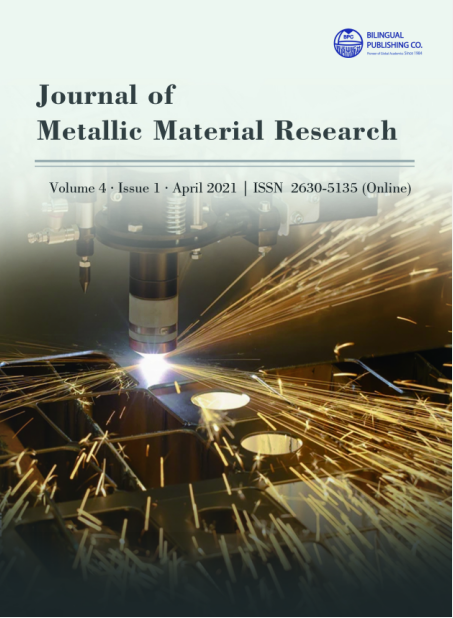-
11271
-
830
-
735
-
508
-
480
Orange Peel Extract Mediated Silver Nanofluid as Corrosion Inhibitor for X80 Steel in Simulated Oilfield Scale Dissolver
DOI:
https://doi.org/10.30564/jmmr.v4i1.3621Abstract
Silver nanofluid was prepared by bio-reduction reaction between orange peels extracts (OPE) and silver nitrate and characterized by spectroscopic and microscopic techniques. Colloidal nanoparticles of sizes between 40 – 50 nm and spherical shape were obtained. The nanofluid was applied as anticorrosion additive to inhibit corrosion of X80 steel in simulated oilfield scale dissolver solution (1.0 M HCl) at various temperatures. The nanofluid (OPE-AgNPs) was 98.9 % and 84.3 % efficient at 30 ºC and 60 oC respectively as determined by weight loss measurement. In comparison with OPE, OPE-AgNPs shows better corrosion inhibition and higher resistance to thermal degradation. Some kinetic and thermodynamic models were used to characterize the inhibition process. OPE-AgNPs could be optimized and used as alternative anticorrosion additive for scale dissolution liquor in the industry.
Keywords:
Adsorption, Corrosion inhibitor, Orange peels extract, Silver nanoparticles, Electron microscopyReferences
[1] Rhudy, J. S. (1993). Removal of mineral scale from reservoir core by scale dissolver. In SPE International Symposium on Oilfield Chemistry. New Orleans, Louisiana, March 1993. SPE-25161-MS. https://doi.org/10.2118/25161-MS
[2] Fink, J. (2021). Petroleum engineer's guide to oil field chemicals and fluids. Gulf Professional Publishing.
[3] Ituen, E., Akaranta, O. and James, A. (2016). Green anticorrosive oilfield chemicals from 5-hydroxytryptophan and synergistic additives for X80 steel surface protection in acidic well treatment fluids. Journal of Molecular Liquids, 224, 408-419.
[4] Cicek, V. and Ozdemir, M. (2013). Characterization Studies Of Aqueous Immersion Solutions Of Novel Environmentally Friendly Organometallic Corrosion Inhibitors Used To Cure Mild Steel Substrates In Corrosive Media. International Journal of Engineering Research and Application 3(1), 1455-1461.
[5] Singh, A., Dayu, X., Ituen, E., Ansari, K., Quraishi, M. A., Kaya, S. and Lin, Y. (2020). Tobacco extracted from the discarded cigarettes as an inhibitor of copper and zinc corrosion in an ASTM standard D1141-98 (2013) artificial seawater solution. Journal of Materials Research and Technology, 9(3), 5161-5173.
[6] Ahmed, S., Ahmad, M., Swami, B. L. and Ikram, S. (2016). A review on plants extract mediated synthesis of silver nanoparticles for antimicrobial applications: a green expertise. Journal of advanced research, 7(1), 17-28.
[7] Priyaragini, S., Sathishkumar, S. R., & Bhaskararao, K. V. (2013). Biosynthesis of silver nanoparticles using actinobacteria and evaluating its antimicrobial and cytotoxicity activity. International Journal of Pharmaceutical Science. 5(2), 709-712.
[8] Ituen, E., Yuanhua, L., Verma, C., Alfantazi, A., Akaranta, O. and Ebenso, E. E. (2021). Synthesis and characterization of walnut husk extract-silver nanocomposites for removal of heavy metals from petroleum wastewater and its consequences on pipework steel corrosion. Journal of Molecular Liquids, 335, 116132.
[9] Domingos, R. F., Baalousha, M. A., Ju-Nam, Y., Reid, M. M., Tufenkji, N., Lead, J. R., Leppard, G. G. and Wilkinson, K. J. (2009). Characterizing manufactured nanoparticles in the environment: multimethod determination of particle sizes. Environmental Science and Technology, 43(19), 7277-7284.
[10] Ituen, E., Singh, A., Yuanhua, L. and Akaranta, O. (2021). Green synthesis and anticorrosion effect of Allium cepa peels extract-silver nanoparticles composite in simulated oilfield pickling solution. SN Applied Sciences, 3(6), 1-17.
[11] Ituen, E., Akaranta, O. and James, A. (2017). Evaluation of performance of corrosion inhibitors using adsorption isotherm models: an overview. Chemical Science International Journal. 18(1), 1-34.
[12] Faraj, N., Abdelghani, K. A., Idress, A. A. and Ibrahim, D. M. (2021). L-Proline as a Green Corrosion Inhibitor in Aqueous Solutions for Carbon Steel. Journal of Metallic Material Research, 4(1), 16 -20
[13] Chidiebere, M. A., Oguzie, E. E., Liu, L., Li, Y. and Wang, F. (2014). Corrosion inhibition of Q235 mild steel in 0.5 M H2SO4 solution by phytic acid and synergistic iodide additives. Industrial and Engineering Chemistry Research, 53(18), 7670-7679.




 Ekemini Ituen
Ekemini Ituen





